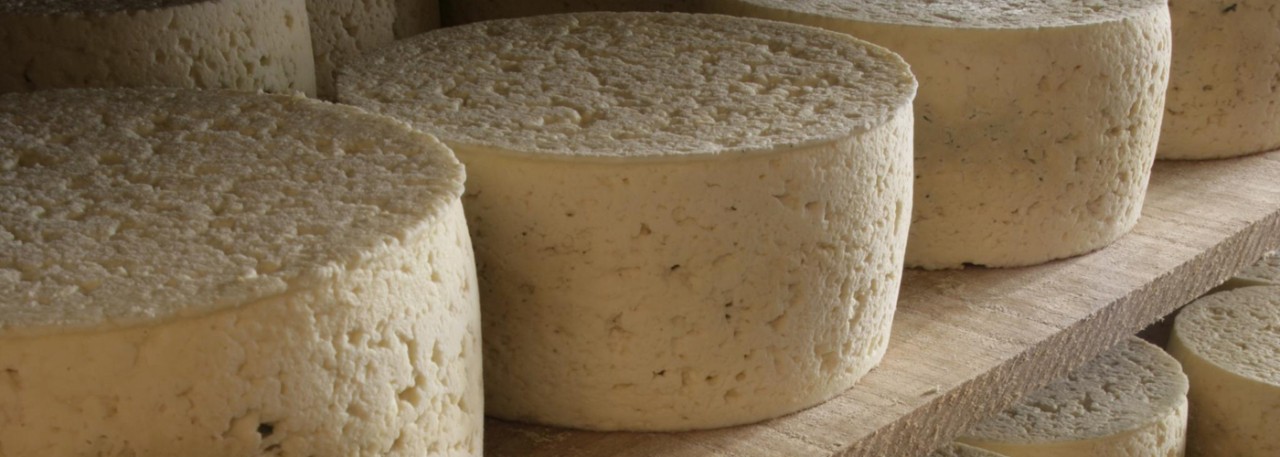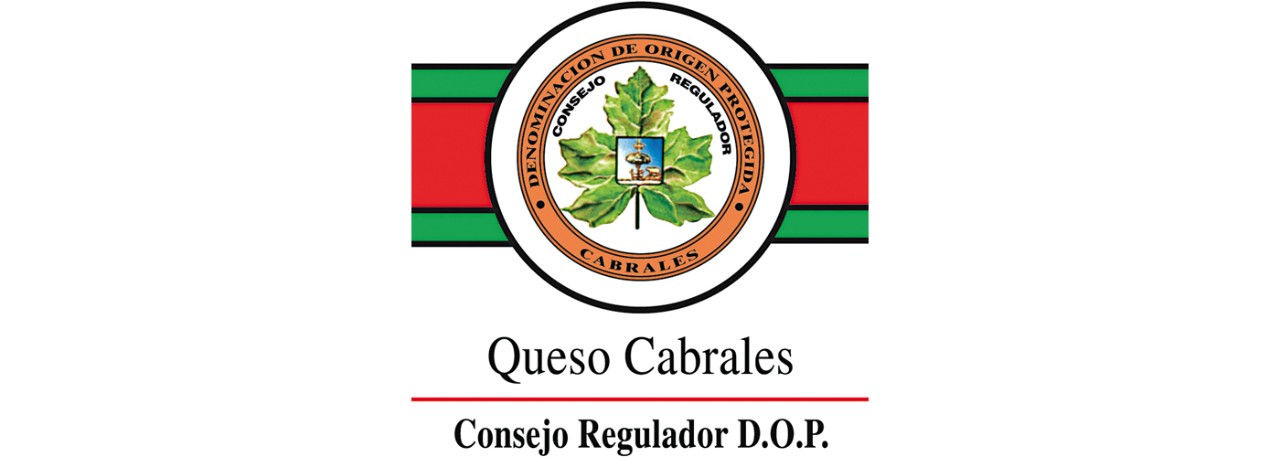.png.transform/rendition-xs/image_image%20(1).png)
Cabrales PDO
Blue-veined cheese made essentially from whole, raw cows’ milk, or from mixtures of two or three types – cows’, ewes’ and goats’ milk. Ripening lasts for a minimum of two months and takes place in natural caves.
Tasting notes
A balanced flavor, varying in intensity depending on the type of milk used. It must not be overly salty, nor bitter nor intensely astringent. It has medium piquancy, especially when made from pure ewes’ or goats’ milk or mixtures. It has a pronounced, persistent aftertaste. The aroma is penetrating and intense, varying according to the type of milk used, with the most intense aroma coming from goats’ milk. The lactic family predominates although, since in this cheese the essential micro-organism is Penicillium, lipolytic activity leads to the liberation of very complex compounds. The smell is clean and pleasant, with a touch of piquancy and nuttiness reminiscent of hazelnut, almond, etc. The texture should be even throughout, with very fine, almost imperceptible graininess.
Other notes
The drums have a flat top and bottom which, in some cases, may be slightly concave. The sides are straight or slightly convex. The diameter and weight vary and the height is 7-15 cm (2¾-6”). The rind is natural, soft, thin, creamy and orangey-brown or grayish and there may be reddish or yellow patches caused by microbial growth. It is slimy to touch because of the microbes that develop on the outside of the cheese during ripening. The consistency of the paste varies from semi-soft to soft, depending on the length of ripening. When ripe, the paste is compact, with no eyes, medium-low stickiness and creamy. The ivory-white color may vary depending on the type of milk used but is the same throughout the paste. There are greeny-blue patches and veins caused by Penicillium molds which become darker in color during ripening but must never be black. The Penicillium should grow evenly throughout the paste.The percentage of fat over dry matter must not be below 45% and moisture must be a minimum of 30%.
Production / Processing method
The milk is soured using natural rennet from the stomach of kids, or powdered rennet, in small quantities so that coagulation takes place slowly. The milk must be kept at 22-23ºC (71-73ºF) for at least one hour for the mixed lactic acid coagulation, which usually requires 2-3 hours.
The resulting curds are broken up carefully to rounded, even-sized pieces 1-2 cm (½-¾”) in diameter.
After draining off the whey, the curds are placed in cylindrical molds where they are left for 2-4 days, turning them a couple of times instead of pressing. The cheeses are then salted by sprinkling salt over the top, leaving them for 12 hours, then turning them and sprinkling them again. After a further 12 hours, they are turned out of the molds.
They are then left to air for about two weeks before taking them to natural caves for ripening. Caves are allotted to individuals or groups and, in many cases, the right to use them, or parts of them, is transmitted from generation to generation.
Relative humidity inside the caves is 90% and the temperature is 8-12ºC (46-53ºF). These conditions promote the natural development of Penicillium-type molds which give the cheese its greeny-blue patches and veins. There is therefore no need, as with most blue cheeses, to add Penicillium spores. For proper ripening, the cheese should remain on wooden shelves in the cave for 2-5 months, being turned and cleaned regularly.
The Regulations used to allow the cheese to be wrapped in sycamore maple leaves (Acer pseudoplatanus), but this practice has now been discontinued, and special, food-grade paper is now required, printed with the green leaves. Packaging is completed with the producer’s label and the PDO label bearing a red stripe between two green stripes, the logotype of the Regulatory Council and the serial number.
Geography / Relief and climate
The production area is in the shape of an inverted triangle. To the south is the Naranjo de Bulnes or Pico Urriellu mountain, rising above 2,500 m (8,202 ft) in the central massif of the Picos de Europa. At the center is the Arenas-Poo-Carreña depression at an altitude of under 200 m (656 ft) and along the north is the Sierra del Cuera, which reaches a maximum height of 1,315 m (4,314 ft) at Pico Turbina.
The geological substratum is mostly Carboniferous with limestone interspersed with slate. The two main soil types are siliceous –mostly slate, quarzite and conglomerates – and lime-rich (limey lithosol and rendzina). The climate is very damp, with annual rainfall in excess of 1,400 l/m2, reaching 2,000 l/m2 in the highest parts of the Picos de Europa. The lowest rainfall is on the slopes of the Sierra del Cuera where there is surplus water all year round.
Temperatures vary greatly, depending on the altitude. In high mountain areas, the average annual temperature does not rise above 0ºC (32ºF). At medium altitudes, it is much warmer and in the river valleys, the average is 6-8ºC (42-46ºF) and there are not such great fluctuations as in higher parts. The production area is mostly located in high mountainous parts, where there is a complex network of rivers, including the Acres river which leads to the Castaño and Dude, as well as other smaller rivers, all form criss-crossing valleys, with meadows on slopes at different altitudes.
The dairy cattle feed on mountain pastures. The most notable characteristics of the herbaceous and other species growing in the Cabrales area are their hardiness and nutritional value. These are species which have adapted perfectly to the limey soil, extreme climate and grazing.
There are two types of pasture – the low areas where the climate is mild and pastures are lush with good grasses for forage and for hay-making, and the high areas where the mountain climate is very extreme and where forage is less abundant but of greater quality. In the latter, pastures are mostly used for forage and only occasionally for hay-making. The economy of the lower areas is based on milk production, and in higher ones on cheese production.
Regulatory Council
Consejo Regulador de la DOP Cabrales
Carretera General, s/n
33555 Carreña de Cabrales
Asturias
Tel: (+34) 985 845 335
dop@quesocabrales.org
www.quesocabrales.org
Sources:
- Spanish Ministry of Agriculture
- Regulatory Council, Cabrales PDO
Cabrales must not be overly salty, nor bitter nor intensely astringent. It has medium piquancy, especially when made from pure ewes’ or goats’ milk or mixtures. It has a pronounced, persistent aftertaste.


- Cabrales 1
- Cabrales 2

Carreña de Cabrales (Asturias)
